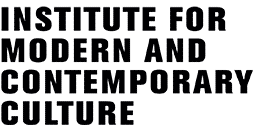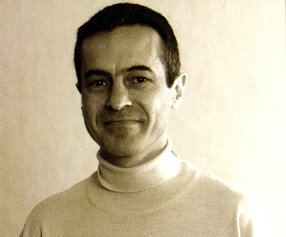José Luis Brea (1957-2010) In Memoriam
(1957-2010)
In Memoriam
Anna Maria Guasch, University of Barcelona
At the end of August 2010, the publication of what would sadly turn out to be the penultimate text written by José Luis Brea, Professor of Aesthetics and Contemporary Art Theory at the Universidad Carlos III of Madrid, awoke in many of us a deep feeling of sorrow and anxiety. The article in salonKritik, the online magazine he founded, was not by any means a farewell or some autobiographical sketch, but the comprehensive re-issuing of a text that served as a theoretical basis for the exhibition ‘The Last Days’ (Seville, 1992). During those years, José Luis Brea proved himself to be ahead of his time when it came to leading the way in new curatorial practices, with his exhibition ‘Before and After the Enthusiasm’ (Amsterdam, 1989) and with his essays that explored the end of the so-called Age of the Enthusiasm and the advent of the new ‘Cold Auras’.
The message carried by the re-publishing of Brea’s article was very clear: All those who knew well José Luis were very aware of his illness – although we couldn’t imagine that the end of his life was so near and his last days so close.
Thus, it was only a few days later that we understood with great sadness that the article, in which he refused any apocalyptic temptation and rejected any perception of cultural agony, was the chronicle of his own death. And while it may have marked the death of its author, it did not mark end of the World he studied and observed.
The article was published within the ‘free thoughts’ section of salonKritik, a section that defines Brea’s open-minded and versatile approach to the theoretical and critical discourses of the last decades. Demonstrating a freer and more rhizomatic way of thinking, Brea’s approach was the basis of scholarly essays as important as El tercer umbral. Estatuto de las prácticas artísticas en la era del capitalismo cultural (Premio Espais a la Crítica de Arte, 2003) or his very last book, Las tres eras de la imagen: Imagen-materia, film e imagen (2010) as well as experiments in critical literature in Las Auras Frías (finalista Anagrama de ensayo, 1990), Un ruido secreto. El arte en la era póstuma de la cultura (1996) or La era posmedia. Acción comunicativa, prácticas (post) artísticas y dispositivos neomediales ( 2002).
Brea’s approach grew out of the work of philosophers such as Deleuze and Nietzsche, and he was most at home inside reticular structures in constant flow. Or, to put it in his own words, inside dynamic systems, permanently instable, at the very heart of thinking machines drawing the outlines of desire, openings, displacements, figures, constant becomings … (Por una rizompolítica, 14 August 2010),
Only with these Deleuzian concepts in mind can we fully understand the texts he published in Estudios Visuales, the magazine he also edited from 2003 to 2010 and the magazine that introduced the rhizomatic system of thought represented by visual studies to Spain. Undoubtedly, his work on Estudios Visuales will also be remembered for the astonishing success of the first Congreso Internacional de Estudios Visuales (Arco, 2004), a conference that brought the international concepts of multi-disciplinarity, the visual turn, synaesthetic visuality, scopic regimes, and all those ideas that have contributed so strongly to the de-activation of power structures inside academia to the Spanish cultural system.
Having found a different position from W.J.T. Mitchell, Mieke Bal, Keith Moxey and Martin Jay (with whom he shared and discussed an epistemological approach to images), Brea built a whole corpus of thought described in his much quoted work Estudios Visuales. La epistemología de la visualidad en la era de la globalización (2005), the first in a series of books he directed for the Spanish publishing house Akal.
Brea was also interested by the idea of the universality of knowledge and the new humanities, by the relationship between aesthetic philosophy, history of art and visuality, and by the mixtures and meeting points between and amongst art, science and technology. Furthermore, he pioneered new curatorial practices, represented by his on-line exhibition La conquista de la ubicuidad (2003), through texts such as cultura_RAM (2007) and by the art websites and online magazines he founded, such as Aleph and artes.zin. However divergent these practices, Brea exhibited in all of these cultural forms a devotion to addressing the complex and fascinating mutations of culture in the age of electronic media.
José Luis Brea was never a compromising thinker. He didn’t hesitate to articulate acute and almost heroic critiques of a certain kind of museum politics, even if his critiques ended up misunderstood, sometimes perhaps wilfully so. He championed free thinking, away from power and far away of what he called ‘pitiable well being’. But most of all, José Luis was adept at something quite uncommon in our field of research: generosity. This generosity could not only be found in his relationship with friends and colleagues, but was also demonstrated in its most difficult sense, as academic generosity. Exploring his website, www.joseluisbrea.net, is enough to realise that his wisdom crossed the boundaries represented by the often hegemonic cultures of writing, the library or the archive. All, or nearly all, of his thought and his work is freely available online, and has long been available for the ‘global’ reader.
And José Luis did all this without ever forgetting what he called ‘affectivity economy’, a geography of affections, that was precise and crystallographic. It is this mineral metaphor that pervades his very last article for salonKritik, an article that, according to his own wishes, was to be read only after his death. In his essay Mineralidad absoluta (el cristal se venga), an essay influenced by Nietzsche, Brea uses the image of the ‘crystal’ in order to partially hide the vertigo provoked by the idea of an imminent death. Crystals are the purest expressions of minerality, as Nietzsche reminded us when he wrote about our common final destiny in the mineral kingdom. Unbendingly courageous, Brea tells us about his consciousness for the very last time, with no return, of a life in perennial flux, of an absolute materiality that, rather than the dark hole in the heart of matter turns out to be the nucleus from which light emerges, in which the interconnected places cause synaptic sparks that carry us to the unexpected: the final destiny.
In another of his key works, Noli me legere (2007), Brea brought to the fore the rhethoric implicit in all languages, carving out a position between Benjamin’s stress on allegory as a paradigmatic figure of the artistic discourse and the tendency to drift away from the logical-semantic values of language in order to, following Nietzsche, stress its instrumental value, a value that encourages action. As Brea wrote, and this thought might be a good epitaph: ‘Language is more of an instrument of the Will of Power than of a tool for the representation of the World’. Rest in peace, dear friend.
Translated by Javier Montes.
Anna Maria Guasch, Professor of Contemporary Art. University of Barcelona, Spain.


The Institute for Modern and Contemporary Culture
University of Westminster Department of English, Linguistics and Cultural Studies
32-38 Wells Street, London W1T 3UW. United Kingdom.


No comments yet
Leave a comment